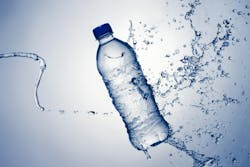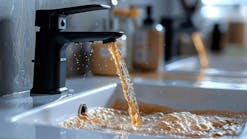Health consciousness is on the rise, say experts, a trend that is reflected in emerging food and beverage preferences, such as low-alcohol beer and plant-based meals. It is no surprise then that people are choosing to drink water instead of other, less-healthy drinks more today than ever before.
The International Bottled Water Association (IBWA) thinks that water is the best and healthiest choice for hydration. Whether it’s bottled water, filtered water, or tap water, people should always be encouraged to drink water from any of these sources.
Research shows that “water drinkers” consume water as their drink of choice, with 73% of people surveyed by The Harris Poll (for IBWA) saying they consumed water from all three water sources: bottled, filtered, and tap. Only 19% of people said they “only” drink bottled water and 8% said they “only” drink filtered or tap water.
In addition, a younger generation has developed a taste for refreshing and simple water, as new data shows far fewer young people are consuming sugar-sweetened beverages compared to two decades ago.
Water drinkers (the 73% who drink water from all sources) choose a type of water based on their circumstances. Forty-eight percent of bottled water drinkers also consume filtered or tap water at home and they drink bottled water away from home – at work, social engagements, entertainment and sporting events, the gym, and traveling – where bottled water is readily available alongside other packaged beverages. In fact, sales data from Beverage Marketing Corporation (BMC) shows that since 2010, approximately 44% of the growth in U.S. bottled water consumption has come from people switching from carbonated soft drinks and juices to bottled water, which outsold soda for the first time in 2016 and has remained America’s favorite packaged drink every year since.
The health benefits of choosing water over other drinks are undisputable. Water is essential for life. It supports metabolic reactions—such as the formation of urine (approximately 95% water), sweat (approximately 99% water), and blood plasma (about 92% water). Other parts of the body function best when adequately hydrated, such as the brain, joints, muscles, kidneys, heart, digestive system, gallbladder, and urinary tract, to name a few.
Drinking zero-calorie and zero-additive beverages, such as water, instead of sugar-sweetened drinks, is regularly cited as a key component of a more healthful diet. In fact, the Dietary Guidelines for Americans recommend the strategy of choosing water in place of sugar-sweetened beverages to reduce the intake of added sugars.
“Our thirst sensation doesn’t really appear until we are 1% or 2% dehydrated. By then dehydration is already setting in and starting to impact how our mind and body perform,” said Lawrence Armstrong, PhD, FACSM, professor emeritus, University of Connecticut, and Drinking Water Research Foundation trustee. “Dehydration affects all people, and staying properly hydrated is just as important for those who work all day at a computer as it is for marathon runners, who can lose up to 8% of their body weight as water when they compete.”
With all the compelling science on the benefits of having water as the first and best choice for hydration, it is little wonder that people are deciding to choose water instead of other less healthy drinks on their own. As such, IBWA spends little time and effort marketing bottled water to consumers. Instead, the association's efforts are often focused on countering the false and misleading information spread through communities and on social media by a small but vocal minority of people.
The false claims are as familiar as a pair of well-worn slippers: “the bottles leach chemicals,” “the industry isn’t regulated,” “expensive and wasteful,” and “bad for the environment.” All of those claims are easily debunked.
Regulation
Bottled water is comprehensively regulated as a food product by the U.S. Food and Drug Administration (FDA). Bottled water must comply with the general FDA good manufacturing practices (GMPs) for foods (21 CFR Part 117), specific bottled water GMPs (21 CFR Part 129), and bottled water standards of identity (21 CFR 165.110 (a)). All bottled water products—whether sourced from groundwater or public water systems—are produced utilizing a multi-barrier approach, which includes one or more of the following: source protection, reverse osmosis, distillation, micro-filtration, carbon filtration, ozonation, or ultraviolet (UV) light. The finished water product is then placed in a sealed bottle under sanitary conditions and sold to the consumer.
Often, the false narrative is that bottled water is less regulated than tap water. We do have a good response to this false claim, which is: By federal law, FDA regulations governing the safety and quality of bottled water must be as protective of the public health as the Environmental Protection Agency (EPA) standards for tap water. (See 21 U.S. Code §349.) FDA must review every new EPA maximum contaminant level (MCL) and monitoring requirement for public drinking water to determine if it should apply to bottled water. FDA has 180 days after the date of each EPA final rule to make that decision. If FDA takes no action, the new EPA standard for tap water will, by operation of law, become applicable to bottled water.
Plastic leeching
PET plastic containers do not contain ingredients capable of producing dangerous substances under conditions of normal use, including being subjected to heat. PET plastic has been approved as safe for food and beverage contact by the FDA and similar regulatory agencies throughout the world for more than 35 years. PET plastic is the packaging material of choice for many other beverages—including soft drinks, juices, beer, wine, and spirits—and other food products—including peanut butter, salad dressings, condiment containers, vitamins, and vegetable oil—because of its transparency, stability, high-pressure resistance, barrier properties, flexibility and light weight. PET’s versatility is but one reason why thousands of other food products, in addition to bottled water, are packaged in PET plastic.
Environment
Of all packaged drinks, bottled water has the smallest environmental footprint. Here’s why: PET water bottles use less than half of the material weight of all other packaging types — including aluminum cans, paperboard cartons, glass, and even PET soda bottles. For comparison, a PET bottled water container weighs, on average, 8.8 grams; a PET soda bottle weighs 22.2 grams, due to carbonation and manufacturing processes. Lower material usage means less impact from material extraction, manufacturing, and ultimately results in less material entering landfills or needing to be recycled. A graphic IBWA produced explains the life-cycle specifics quite well.
Recycling rate
Bottled water containers are among the easiest packaging types to recycle and make up 49% of all PET plastic beverage containers collected in curbside programs in the United States. Overall, all PET plastic bottles and jars have a recycling rate of 29.1%, according to the EPA. On that same EPA webpage, the agency reports the recycling rate for ALL plastic (PET, HDPE, PP, etc.) is 8.7%.
Bottled water containers are 100% recyclable—even the caps, and PET bottled water containers are the most recognized and most recycled containers. Even though bottled water containers have a higher recycling rate than other beverage containers, we know that we need to work at improving recycling rates further by educating consumers about the value of recycling all recyclable packaging.
Bottled water competition
The bottled water industry does not consider tap water to be its competitor in the marketplace. Instead, bottled water competes with other packaged drinks, such as carbonated soft drinks, fruit juices, and energy drinks, all of which require far more plastic packaging (at least 167% more plastic) due to carbonation and manufacturing processes.
Bottled water is one way safe drinking water is provided to humans. Point-of-use (POU) filtration devices, point-of-entry (POE) filtration systems, and tap water are also capable of delivering safe drinking water. We each have a place and an important role to play in human health and well-being.
Emergencies and natural disasters
Communities across the United States often experience instances of compromised public water systems after emergency situations or natural disasters (e.g., hurricanes, floods, tornados, fires, or boil alerts). During these times, bottled water is a necessary and reliable alternative to deliver clean, safe drinking water. The bottled water industry has a proven record of being ready to help when disastrous events occur, and bottled water companies donate millions of gallons of their products every year to help ensure a reliable source of drinking water is available for the public during and after emergencies. The bottled water industry is there when people need it most, but it’s important to understand the industry can only help during these situations if there is a strong and viable market throughout the year.
Bottled water consumption predicted to increase
IBWA understands the need to grow business, but we disagree with the tactic of using false and misleading information to persuade people to abandon bottled water.
BMC projects bottled water's market share will continue to grow, as more and more consumers choose bottled water over less-healthy drinks. Attempts to deter people from enjoying bottled water will lead people to consume less healthy beverages that contain unwanted sugar, caffeine, or other additives. With the high rates of obesity, diabetes, and heart disease in the United States, discouraging people from choosing bottled water, the healthiest drink option, is clearly not in the public interest.



